Erect-crested penguin
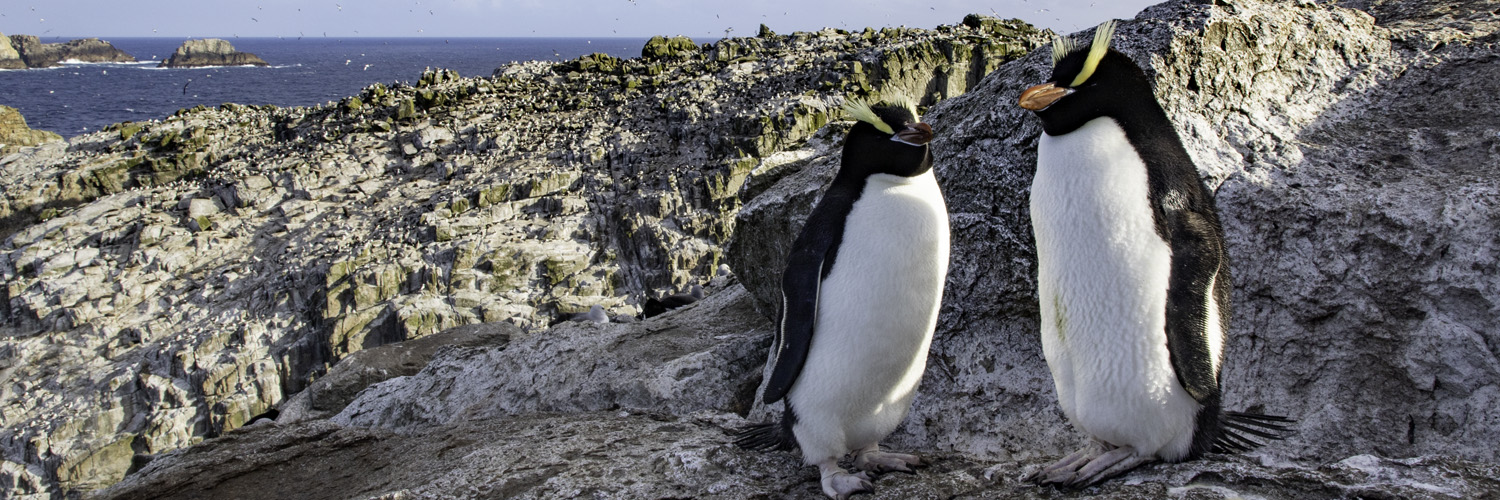
Erect-crested penguin
Eudyptes sclateri
| Kerry-Jayne Wilson & Thomas Mattern | Document date: 12 April 2019; DOI: 10.36617/SoP.erect.2019-04 |
Summary
The Erect-crested penguin (Eudyptes sclateri) is probably the least researched of all the world’s penguins. Historically recorded on Campbell Island, it now breeds only on the Bounty and Antipodes Islands. Their numbers declined throughout the 20th century, although that decline may have slowed in the last two decades. The reasons for the decline are unknown, but for this species introduced predators and fishery bycatch are not implicated. Erect-crested penguins are related to, larger than and distinct from, the two other crested penguins endemic to New Zealand, Fiordland penguin (E. pachyrhynchus) and Snares penguin (E. robustus). Another now extinct crested penguin, was probably also endemic to the New Zealand region, and based on mitochondrial DNA, was sister to the erect-crested. This taxon (currently referred to as Eudyptes Clade X) was probably hunted to extinction following human arrival.
Erect-crested penguins are assumed to feed well offshore and migrate to parts unknown between breeding seasons. They arrive at the Antipodes and Bounty Islands in September, chicks are fledged in late January, there is a pre-moult exodus of about one month, many moulting at their breeding colonies. Once moult is finished the penguins remain at sea until they return to breed about six months later.
As with other Eudyptes penguins, Erect-crested penguins are sexually dimorphic, with males being heavier and with larger bills than females. Weights and measurements of sexed adults are given by Warham1 who found yearlings and even fledglings showed dimorphism in bill measurements1,2.
Previous reviews of of biology and priority lists
The chapter by Davis3 presents a good review of what little is known about this enigmatic penguin. Marchant & Higgins4 is more encyclopaedic drawing together snippets of information often overlooked in other reviews. The comparative review of the crested penguin species by John Warham2 is still a useful overview particularly of those species that breed in the New Zealand Region.
Other descriptions of the Erect-crested penguin5,6, were written primarily for the lay person and provide brief introductions to the species.
Two recent workshops, one for seabirds in general7 the other for New Zealand penguins8 identified research required for the conservation of New Zealand penguins. Neither went through peer review and both are less detailed than required for our purposes. Research and conservation priorities for Erect-crested penguins have been listed by Taylor9, Davis3 and Baird10; all are brief, all identify on-going declines being of concern, and serve to emphasise how little is known about the species, its threats or the conservation actions required.
Conservation status
The Department of Conservation lists the Erect-crested penguin as ‘declining’11 and IUCN as ‘endangered’12, due to its restricted breeding range and recent population declines.
Distribution
Erect-crested penguins breed on the Bounty Islands (Proclamation, Tunnel, Depot, Ruatara, Penguin, Lion, Spider, Funnel, Molly Cap and North Rock) and Antipodes Islands (Antipodes, Bollons, Archway and Windward Islands3,9,13–15. A few have bred on Disappointment IslandA few have bred on Disappointment Island in the Auckland group but none has been seen during annual visits since 2015 (P. Sagar pers. comm.). In the 1940s and in 1958 small numbers bred in amongst rockhopper penguins on Campbell Island16, but perhaps not the several hundred suggested by Davis3. In 1938 and 1939 a pair nested on Otago Peninsula17 but there are no recent records of them breeding on Campbell Island or the New Zealand mainland. A female Erect-crested penguin bred with a male Snares penguin at The Snares in 2013; an egg was laid but the breeding attempt failed18.

Figure 1. Erect-crested penguins breeding in conjunction with Salvins albatross on Proclamation Island, Bounty Islands.
Erect-crested penguins are seldom seen at sea, during the breeding season sightings have been made 160 km ESE, and 255 km E of the Bounty Islands and on approach to those islands4. They are assumed to be pelagic when not breeding or moulting, but where they go is unknown. Most sightings and beach-stranded birds found along the south-eastern coasts of the South Island have been found between March and July suggesting that at least some of the penguins move north during winter4,19.
Between breeding seasons, they are regularly seen on The Snares, the other sub-Antarctic Islands and Chatham Islands, less often on south-east coast of the South Island and Stewart Island, as vagrants in Wellington, Wairarapa, Hawke’s Bay and very rarely elsewhere around the North Island9,19. Dates of observation and the location of vagrant Erect-crested penguin sightings are listed by Marchant & Higgins4. Beyond New Zealand, vagrants have been seen at Macquarie Island20 and southern Australia21, and very rarely at the Falkland Islands, Marion Island and Heard Island, where they have been observed attempting to breed with the crested penguin species resident on those Islands18 with one at sea record in the southern Indian Ocean22.
Numbers and population trends
On the Antipodes Islands, Erect-crested penguins breed in mixed colonies along with eastern rockhopper penguins (E. filholi); the two species readily identified from one another during ground counts but not when counted from clifftop observation points or from boats, as is necessary for some colonies.
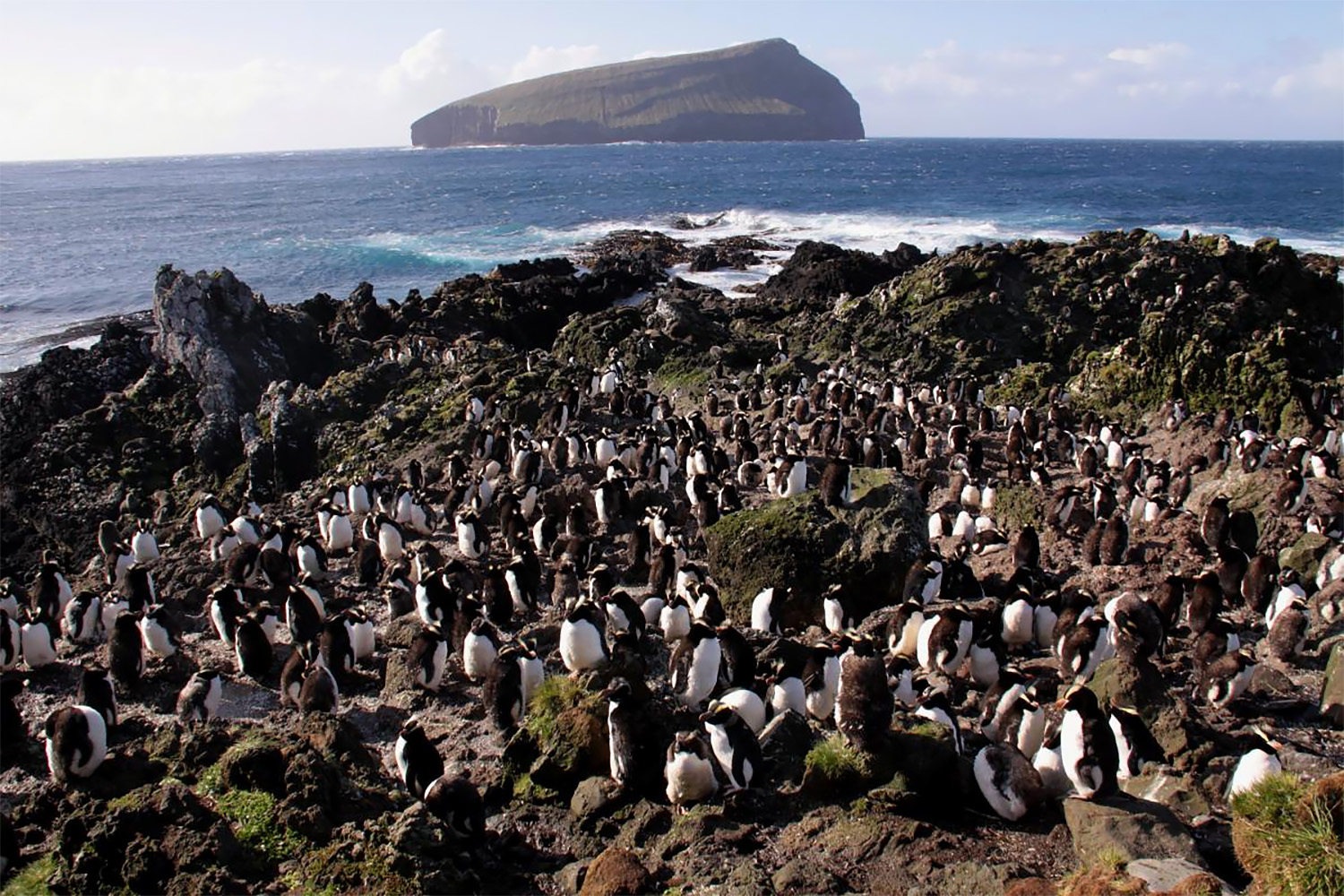
Figure 2. Erect-crested penguin colony with Bollons Island in background, Antipodes Island, March 2009 (Photo: Mark Fraser, NZ Birds Online)
There are few attempts to estimate population numbers of Erect-crested penguins but substantial differences in methodology limit direct comparisons3,9. Robertson & van Tets13 estimated 115,000 breeding pairs to be present on the Bounty Islands in 1978 using nest densities on one island to extrapolate to the entire Bounty Island land area deemed suitable for breeding. A similar approach was used in 1997, that estimate being just 27,956 pairs, but as the two studies used different estimates of the area suitable for nesting the two counts are not strictly comparable9. A total of 2,774 Erect-crested penguin nests were counted on Proclamation Island, Bounty Islands 12-16 November 199723.
Equally unreliable, seems to be a population estimate for on the Antipodes Islands also of 115,000 pairs in 1978, with no details presented describing the methodology that was used to derive this “very rough”24 population estimate.
Therefore, estimates provided by Robertson & van Tets13 and Taylor24 - and by extension numbers provided in Marchant & Higgins4 which are based on these sources - are of unknown reliability and we have chosen to use them with great caution.
What can be said with certainty, based on photographic evidence, is that the Erect-crested penguin population on Antipodes Island declined substantially between 1949 and 198924. Between 1995 and 1998, numbers declined by a further 26% (Table 1) when comparable census methods were employed in both years3.
A full ground census on the Antipodes Islands in 2011 recorded about 39,700 breeding pairs which appears to be comparable with the 1998 estimates14. Hiscock25 includes the location of and the counts made at each individual colony in 2011 and for each sector of the Island in 1995, 1998 and 2011. Twenty-four colonies mapped in 1978 had been abandoned by 201114.
The most recent partial survey in November 2014 found the breeding population in those colonies resurveyed had declined, on average, by a further 19% since 201126. In January 2014, a major storm caused extensive landslides on the Antipodes Islands with 44% of the Erect-crested penguin colonies losing area due to landslides or were partially buried by landslide debris26.
About 20 birds nest on Inner Windward Island, Antipodes Islands27.
| Year of count | Estimated number of active nests | Change since previous estimate | Reference |
|---|---|---|---|
| 1995 | 52,081 | n/a | Lloyd Davis3 |
| 1998 | 38,540* | -26% | Lloyd Davis3 |
| 2011 | 39,700** | no change | Hiscock & Chilvers14 |
| 2014 | *** | -19% | Chilvers & Hiscock26 |
| * 1998 figure derived from a partial count only. **34,226 (93%) of the 36701 penguin nests counted in ground counts were Erect-crested penguins, the remaining 2475 were rockhopper penguins, in all 42,689 nests were counted, the remainder from observation points or from a boat, 39,700 is 93% of that total. **Calculated using ground counts in colonies censused on both occasions. ***Partial count only. |
|||
From the information at hand it is certain that the Erect-crested penguin populations on both Antipodes and Bounty Islands have undergone significant declines in the 20th Century. However, more robust data are required to assess the extent of those declines and current population trajectories.
TBased on the timing of breeding cycles, it has been suggested that Erect-crested penguins breeding on the Bounty and Antipodes Islands may represent separate ‘cryptic’ taxa. However, a brief examination of mitochondrial DNA by Cole et al.28 did not show any genetic structure in samples obtained, refuting the separate taxa hypothesis.
Cole et al.28 used ancient DNA to genetically identify penguin bones collected from natural fossil deposits and archaeological middens throughout New Zealand. For those few Erect-crested penguin bones (probably vagrants) found, comparison of the mitochondrial Control Region (a commonly used ‘population’ proxy for assessing genetic diversity) from the bone samples (n=2), with historical museum skins (n=10) and contemporary blood (n=18). did not indicate any decline in genetic diversity over time, however, as so few bone samples were available, the results should be interpreted with caution. Future assessment of population demographics using genomic information derived from Single Nucleotide Polymorphisms or whole Genomes, techniques currently in development, may provide clues on the extent of decline in numbers and genetic diversity of Erect-crested penguins.
Demography
Regular monitoring of Erect-crested penguins – at least of the Antipodes population – is of high priority. The last full Island survey was conducted between 22 October and 6 November 201114. They used ground counts in GPS mapped colonies and present methodology appropriate to and repeatable for Antipodes Island. Hiscock25 describes the survey methodology in greater detail and identifies each of the then extant colonies. They arbitrarily recommend their survey be repeated at five yearly intervals, we suggest two consecutive years at random 3 to 6-year intervals. Some colonies were recounted in 201426 (Table 1).
There is no monitoring of the Bounty Island population.
Breeding biology
On the Antipodes Islands Erect-crested penguins breed on rocky coastal slopes and ledges along with rockhopper penguins, the smaller, later arriving rockhoppers tending to use higher and more broken ground than the Erect-crested penguins1. Erect-crested penguins put little effort into nest building, at best nests consist of a few stones or bits of vegetation, some pairs laying directly onto bare rock3,29. On the Bounty Islands, the penguins nest around the margins of open spaces and in crevices, often using bones or decomposing animals for nesting material, avoiding the open flatter ground occupied by the more aggressive Salvin’s albatross (Thalassarche salvini) (Robertson & Van Tets13, figures 5 & 6, P. Sagar pers. comm).
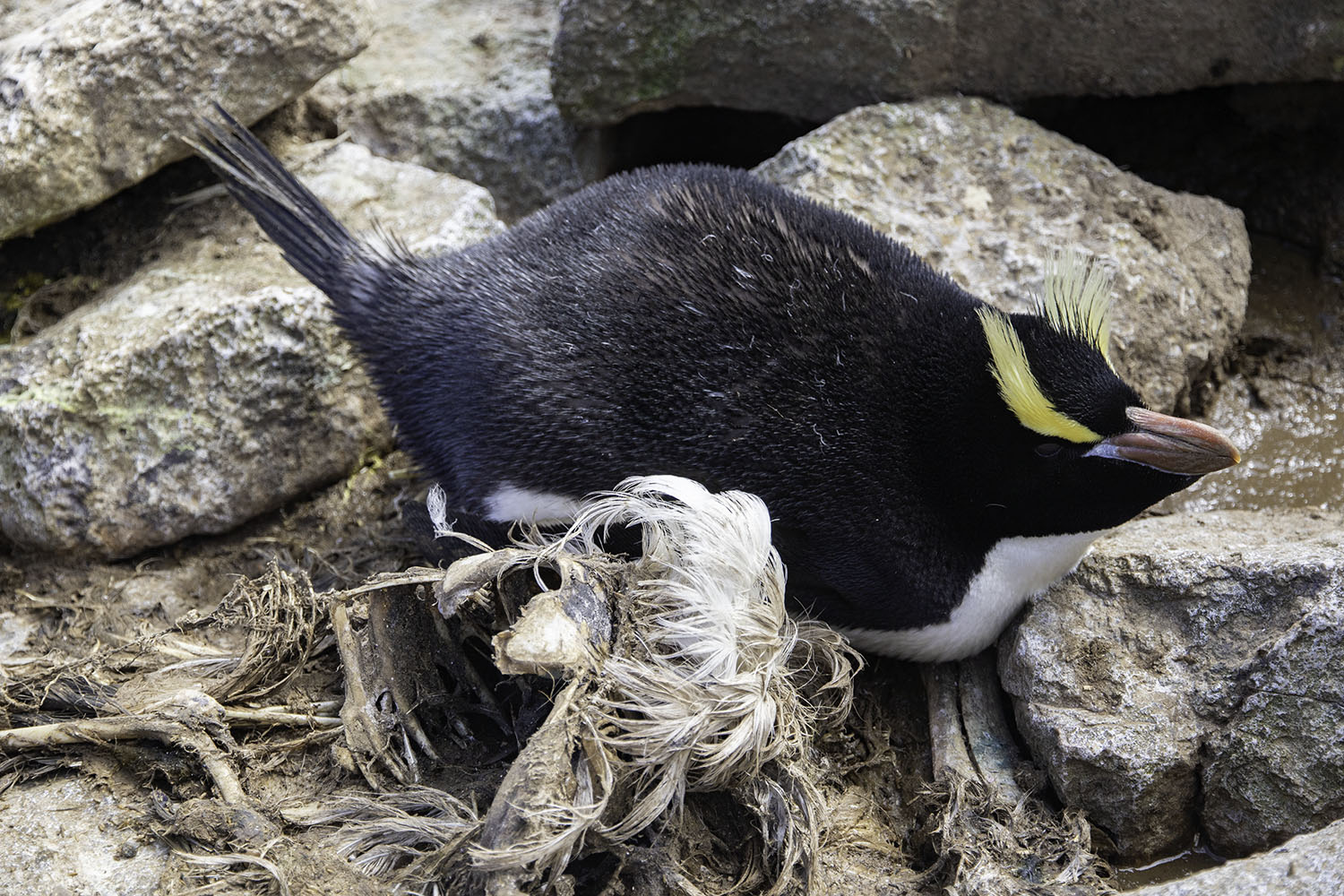
Figure 3. Erect-crested penguin breeding incubating its egg on the carcass of a Salvins albatross, Proclamation Island, Bounty Islands, October 2019.
There has been no full season study of the breeding cycle of the Erect-crested penguin. The classic paper by John Warham1 was based on observations made at the Antipodes Islands between 28 January and 12 March 1969. Further observations were made during a short visit in October 199030 and from September to November 199829.
At the Antipodes Islands Erect-crested penguins lay three to four weeks earlier than the rockhopper penguins that share the island with them2. Erect-crested penguins return to the Antipodes Islands in September, males a week or so before the females, and are ashore for about 23 days before eggs are laid. The first returning bird was seen by shipwrecked mariners on 5 September 1893 who recorded the first egg being laid on 2 October1. As with other Eudyptes penguins they lay two eggs, the first being much smaller than the second. The larger B eggs were laid between 9 and 16 October 1990, peak B egg laying being 12 October, with the A eggs about 5 days earlier30. Chicks hatch in the second half of November after an incubation period of about 35 days. Peak fledging was about 30 January in 1969, with just a few chicks remaining by 12 February1. There are no data on breeding success from the Antipodes Islands, and only very limited data on breeding success at the Bounty Islands15.
The breeding season is said to be two to three weeks later on the Bounty Islands than at the Antipodes13, although in 1997 at the Bounty Islands the first eggs were laid on 5 October15 and the first egg had pipped on 17 November23.
Both parents share incubation duties, there is no data on the length of incubation spells. As with other crested penguins, chicks are guarded by the male for the first three weeks after hatching, during which time the females return to feed the chick most days1,2. After about 10 December the chicks are left alone, often forming crèches. When parents return, the chick chases after its parent with 6-10 deliveries of food during a feeding chase1; food transfer parent to chick taking place up to 10 m from the nest2. Peak fledging has been recorded for the Antipodes Islands around 30 January with most chicks having left by 12 February; parents appear to leave for the sea soon after feeding their chick1 .
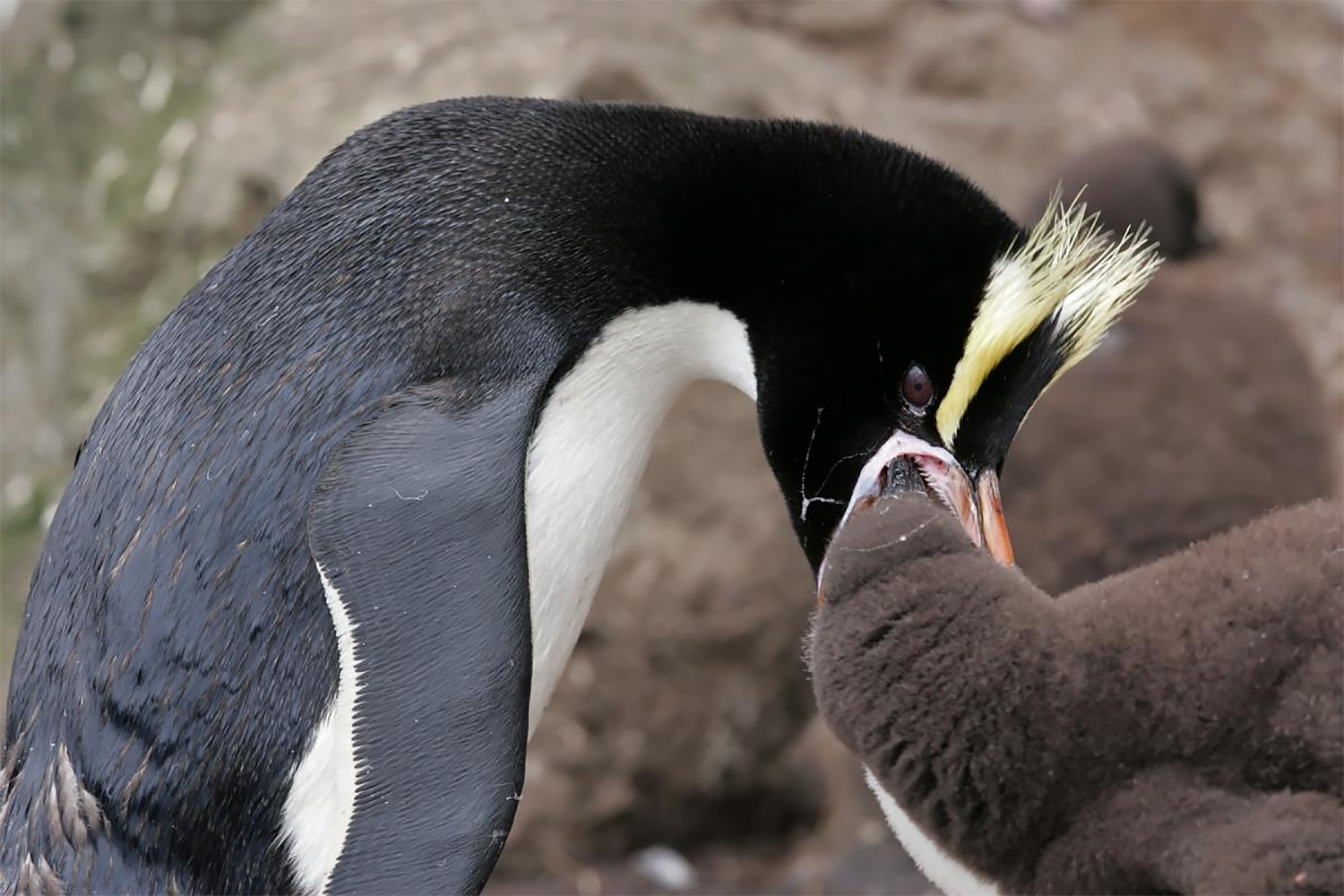
Figure 4. Erect-crested penguins feeding its chick, Antipodes Islands, December 2009 (Photo: David Boyle, NZ Birds Online)
Egg-size dimorphism is more extreme than in con-generic species with the second laid (B) egg being 85% heavier than the first laid (A) egg3,30. Measurements of A and B eggs for Antipodes Island penguins are given by Davis3 and Miskelly & Carey30 and for Bounty Island birds by Amey23. The mean interval between laying A and B eggs was 5.4 days, the longest between egg interval for any bird3. The Erect-crested penguin is an obligate brood reducer; 80% of A eggs were lost before or on the day the B egg was laid, and the remainder lost within six days of laying the B egg3,29,30. Little if any attempt was made to incubate the A egg before the B egg was laid. Davis29 suggested that the eggs are so dissimilar in size that it is essentially impossible to incubate both successfully. Penguins laying later tended to produce larger eggs than early laying birds, and early layers tended to lose the A egg sooner than those that laid late. Davis29 suggested that the A egg serves as a primer stimulating the birds into full breeding mode. Why then do other Eudyptes penguins, where egg dimorphism is less extreme, often incubate both A and B eggs, and hatch both chicks, the Fiordland penguin sometimes even fledging two chicks? An alternative hypothesis has been postulated by Crossin et al.31. With egg formation in crested penguins often starting while the females are at sea, the extreme egg size dimorphism in Eudyptes penguins could be due to a physiological constraint imposed by a migratory carryover effect and argue against small A‐eggs having a specific, adaptive function.
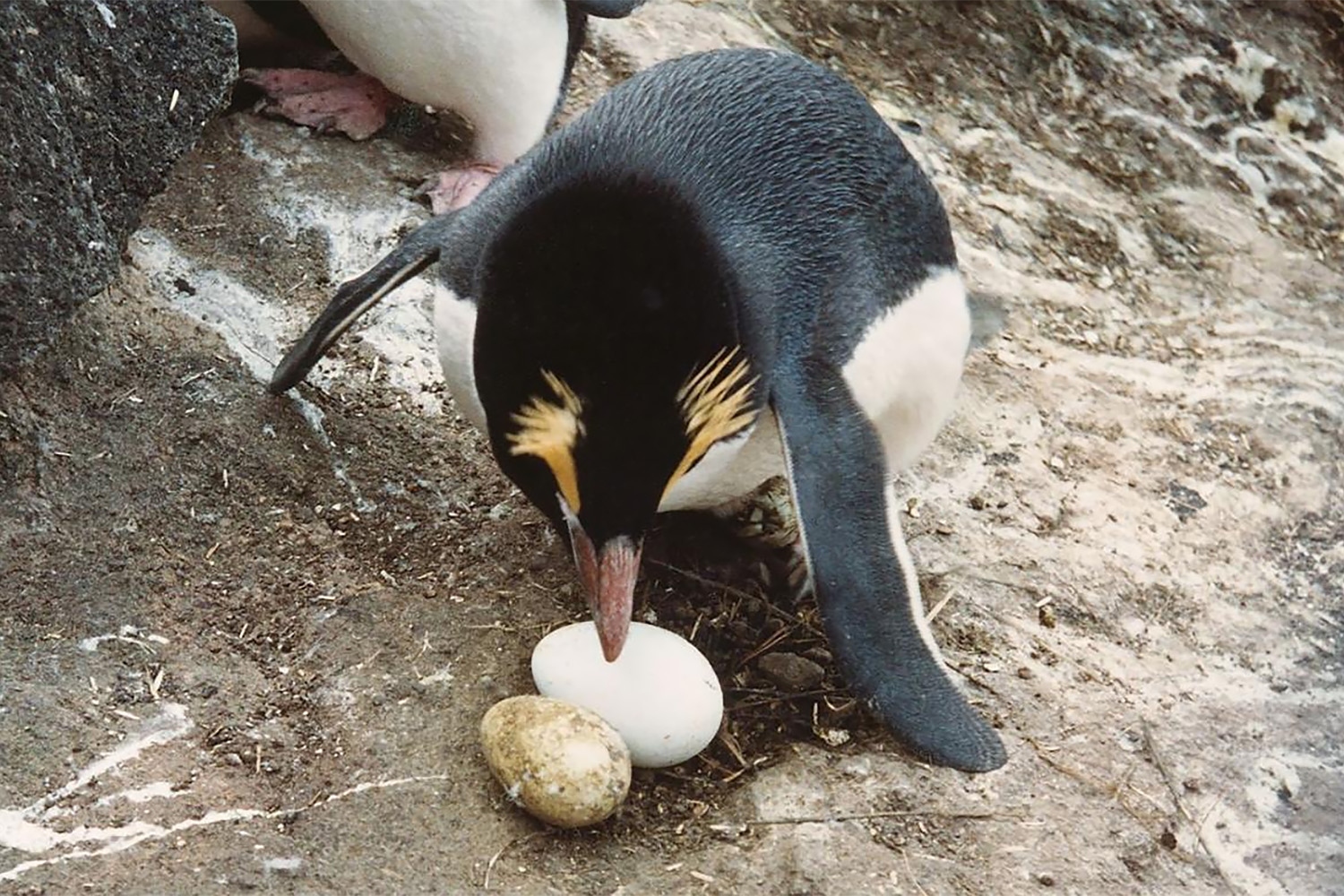
Figure 5. Erect-crested penguin at nest with eggs showing extreme size dimorphism between fresh second egg and stained first egg, Antipodes Island, October 1990 (Photo: Colin Miskelly, NZ Birds Online).
The cause and function of egg dimorphism in crested penguins has been debated by many researchers over the last 50 years but has yet to be satisfactorily resolved. The debate continues, and the current theories are discussed by Morrison32.
There is no data on pair and site fidelity or age at first breeding for Erect-crested penguins.
Moult
Most of those Erect-crested penguins that had bred had departed on their 30-35-day pre-moult sojourn at sea by 4 February 19691. By 27 February 1969 about 75% of the breeding birds appeared to be ashore in pre-moult fat and by 11 March half the birds had begun to shed feathers1. Males tended to arrive before females and many pairs appeared to moult together at their nest site. Most non-breeders had finished their moult by about 6 March. In 1908 shipwrecked sailors recorded the penguins leaving Antipodes Islands having finished moult about 17 April1.
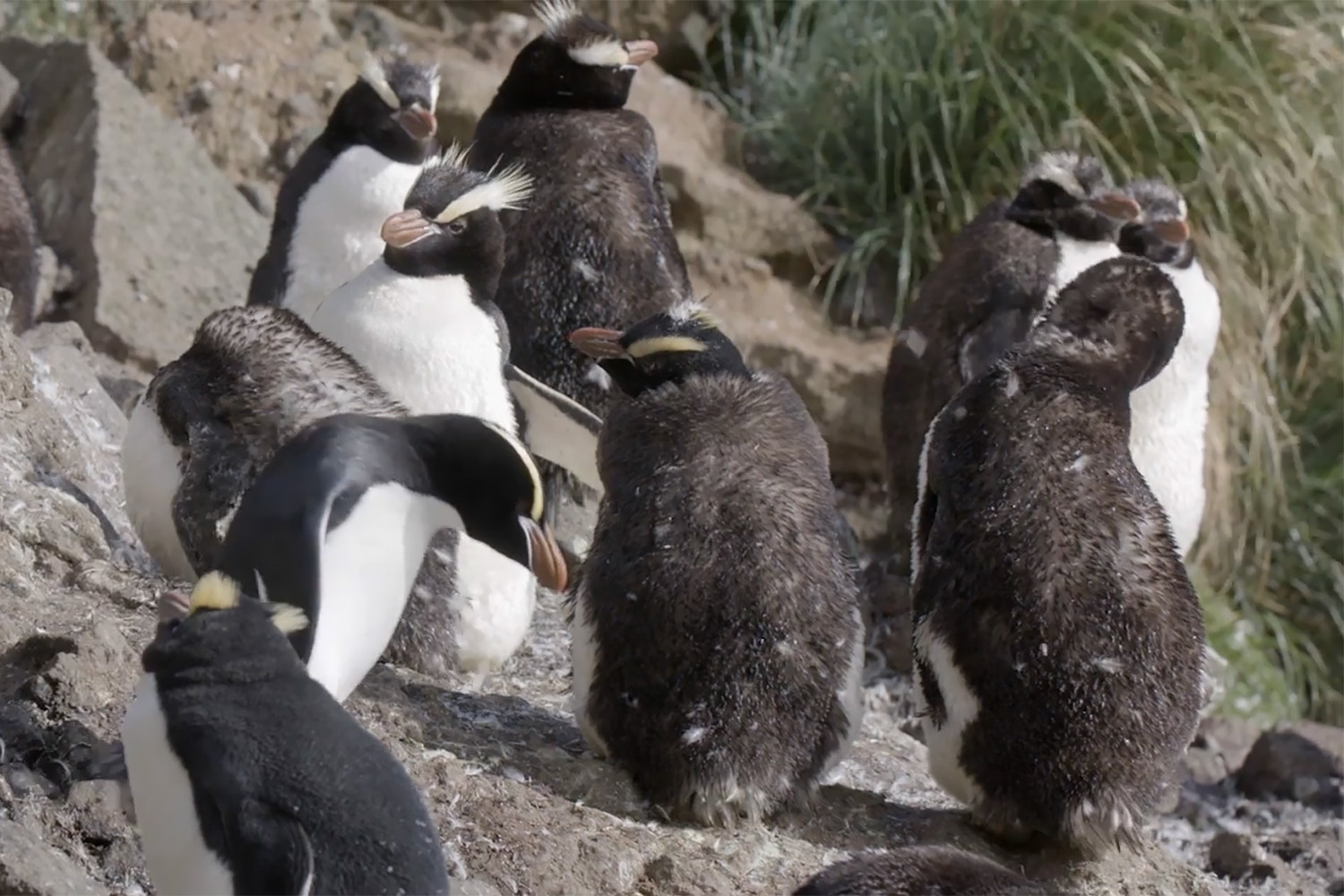
Figure 6. Moulting Erect-crested penguins, Antipodes Islands, March 2016 (Photo: James Reardon, The Million Dollar Mouse project)
Yearling Erect-crested penguins returned to the Antipodes Islands, presumably most to their natal colonies, in late January to early February, most had finished moult by 21 February 1969, but a few remained ashore in early March1. They attained adult plumage at the end of this moult.
Warham1 gives weights of a small sample of sexed Erect-crested penguins at the start and finish of their moult, both sexes lost about 50% of their pre-moult weight during 26-30 days ashore. They left before the tail feathers were fully grown.
Food and foraging
Cooper et al.33 reviewed what was then known about crested penguin diet, but that paper contains no information of the diet of Erect-crested penguins. Feathers have been collected at the Bounty Islands for stable isotope analysis, but results are not yet available (D. Thompson pers. comm.). Information of foods consumed as well as parasites, bacteria and the sex and genotype of the bird can now be obtained by molecular analysis of scats. This is non-invasive and samples can be obtained even during very brief visits. Any study wishing to utilise this method will need to ensure a genetic database (such as GenBank’s BLAST; https://blast.ncbi.nlm.nih.gov/Blast.cgi) of all potential prey items is available to compare sequence data to, as a reduced database will limit the power of the analysis and miss potential food species.
Erect-crested penguins are assumed to be off-shore foragers making long feeding trips3. To date there has been no at-sea tracking of Erect-crested penguins. Dr David Thompson, NIWA, plans to deploy geolocation tags on penguins at the Bounty Islands hopefully in 2019 with retrieval one year later.
Predators
Subantarctic skuas (Catharacta antarctica lonnbergi) prey on penguin eggs and chicks. Fur seals (Arctocephalus forsteri) are known to occasionally kill Erect-crested penguins and leopard seals (Hydrurga leptonyx) may kill the occasional one3,29. Northern giant petrels (Macronectes halli) gathered on the shoreline when penguins fledged; they ate dead chicks but were not seen to kill Erect-crested penguin chicks34.
Disease & parasites
There has been no research conducted into diseases or mortality factors of Erect-crested penguins35.
Threats
The reason/s for the population decline that has occurred, at least since 1978 and probably earlier is unknown. The usual suspects, introduced mammals can be eliminated for Erect-crested penguins; mice (Mus musculus) which were unlikely to pose a threat to penguins, were the only species of introduced mammal on the Antipodes Islands and were eradicated there in 2016. The Bounty Islands have always been free of introduced mammals. Erect-crested penguins are considered to be at low risk from fishery bycatch36. There is only one record of an Erect-crested penguin accidentally caught during fishing operations; a bird foul hooked in the flipper by a ling (Molva spp.) longliner; it was released alive36. Given the remoteness of both island groups pollution and human disturbance appear unlikely3,9. Both island groups are uninhabited with only occasional visits from small parties of scientists or conservation workers.
Changes in the marine environment associated with climate change are more likely to have caused population declines. Fluctuations in the populations of rockhopper penguins at Campbell Island are correlated with changes in sea temperature37,38 and it seems likely that Erect-crested penguins on the Antipodes and Bounty Islands could be similarly affected. Stable isotope ratios from Antipodes Island rockhopper penguins showed a decreasing trend in δ13C since specimens were first collected in 1861, indicating that rockhopper penguin declines may be related to a decrease in either ocean productivity or prey availability39. This is likely to have also affected Erect-crested penguins though evidence to support this is circumstantial.
In January 2014 a major storm caused extensive landslides on the Antipodes Islands, with 44% of the erect-crested colonies losing area due to landslides or were partially buried by landslide debris, with an average 19% decline since those same colonies were surveyed in 201126. The magnitude of the decline was roughly proportional to the area of colony affected, 11.7% decline in colonies not impacted by landslides, 39.9% in colonies that had lost at least 75% of their area to landslides26. With global climate change major storms such as the one in January 2014 are predicted to become more frequent and could further reduce available breeding habitat or kill penguins. The Bounty Islands are essentially bare rock, so landslides are unlikely to impact Erect-crested penguins there.
On the Bounty Islands the growing population of fur seals occupy an ever-increasing area on those islands in the group accessible to seals thus displacing penguins, with the movements of rampaging bull seals further disturbing penguins (P. Sagar pers. comm.).
Given their restricted breeding range a nearby oil spill, perhaps unlikely, could be disastrous.
Feral sheep (Ovis aries), cattle (Bos taurus), Norway rats (Rattus norvegicus) and cats (Felis catus), were present on Campbell Island but all have now been eradicated. There is no known link between these mammals and the apparent local extinction of Erect-crested penguins on Campbell Island.
Research Priorities
Given that this is probably the least known and least accessible of all penguin species, research and conservation management recommendations presented here are of necessity somewhat subjective. As an endangered species with a restricted range whose numbers have declined markedly for unknown reasons, evidence-based management is urgent. Some of the research identified below for the Antipodes Islands could be undertaken in conjunction with the annual Antipodean albatross monitoring.
1. Population monitoring
| R.1.H1 |
Population census on Antipodes IslandsAt Antipodes Islands, island-wide censuses randomly conducted every 3-6 years40. Census methodology for the Antipodes has been described in detail by Hiscock25 who includes nomenclature used to identify each colony. Ideally combine this with annual counts at selected colonies (perhaps using time-lapse camera networks, e.g. Black et al.41,42. The last Island wide census was done in 2011 although some colonies were recounted in 2014. |
| R.1.H2 |
Population census on Bounty IslandsPopulation counts at the Bounty Islands pose even greater logistic challenges but are equally important. The only two archipelago wide population estimates are not strictly comparable but do indicate that major declines have occurred. At the Bounty Islands, drones may make spot counts possible43. Barry Baker will look at aerial photos taken at the Bounty Islands for albatross census to see if they can also be used to count penguins. |
| R.1.H3 |
Repeat the Proclamation Island (Bounty Islands) counts23 at random 3-6-year intervals in October or November. Ground-truthing may make it possible to determine trends using aerial photography, perhaps using drones. |
| R.1.H4 |
Investigate Erect-crested penguin demographyNothing is known about Erect-crested penguin demography, priorities are age at first breeding, mortality at all life stages, recruitment into the breeding population. Automated mark-recapture monitoring may be an option using implanted transponders and reader gates44. Highly desirable but logistically challenging, perhaps feasible at the Antipodes Islands. |
| R.1.M5 |
Photo points from previous Antipodes Islands expeditions to be re-photographed at frequent intervals. |
| R.1.M6 |
Document the impact the growing fur seal population has on Erect-crested penguins on the Bounty Islands. |
| R.1.M7 |
Undertake analyses using genomic data of both Antipodes and Bounty Island populations to test for gene flow and model population demography. |
| R.1.M8 |
In conjunction with research on rockhopper penguins at Campbell Island, scan colonies to see if any Erect-crested penguins still nest there. |
2. Marine Ecology
| R.2.H1 |
Monitoring of marine ecology: foraging behaviour & diet compositionDetermine the foraging range using GPS devices during the breeding season at Antipodes Islands. Ideally during all stages of the breeding cycle but most crucial are those during the chick rearing period. |
| R.2.H2 |
Investigat pre-moult disperalSatellite/GLS tracking of Antipodes breeding penguins during the pre-moult period. |
| R.2.H3 |
Research on Bounty Island penguins is equally important but logistically expensive. Satellite tracking may be feasible but units deployed are expensive and would not be recovered. Dr David Thompson, NIWA, plans to deploy geolocation tags on penguins there hopefully in 2019 with retrieval of these one year later. |
| R.2.M4 |
Foraging behaviour of fledgling penguinsIf feasible track fledglings to document post fledgling dispersal. This study should be repeated every 3-5 years. |
| R.2.M5 |
Stable isotope analysisCollect feathers and blood for stable isotope analysis as an adjunct to other research39. Feathers were collected at the Bounty Islands by D. Thompson, (NIWA) but results are not yet available. |
| R.2.M6 |
Faecal prey DNA analysisCollect faecal samples for DNA analysis to determine prey composition45 at Antipodes and Bounty Island colonies as opportunity allows. |
3. Breeding biology
| R.3.H1 |
Breeding success and cause of breeding failure at Antipodes Island initially, Bounty Islands if possible. |
| R.3.L2 |
More accurate data on timing of the breeding cycle at Antipodes and Bounty Islands. |
| R.3.L3 |
MData on chick growth, meal sizes and fledgling weights. |
| R.3.L4 |
Again, the use of time-lapse cameras should be explored to work towards a better understanding of the breeding biology. |
Acknowledgments
Thanks to Paul Sagar and Tess Cole for their comments on early drafts of this paper and for allowing us to incorporate their observations on the penguins. Graeme Taylor reviewed the research priorities section of this report. Thanks to Barry Baker, David Thompson and Colin Miskelly for information on their planned or past research on Erect-crested penguins. Colin Miskelly, Jacinda Amey and Caroline Cunninghame kindly provided copies of unpublished reports and Louise Chilvers and Jo Hiscock kindly allowed us to include observations of their paper currently in review. This review was funded by the T-Gear Charitable Trust through the Birds New Zealand Research Fund. We are especially grateful to Peter Gaze who facilitated our work and gave encouragement where it was required.
References
- Warham, J. (1972) Aspects of the biology of the Erect-crested Penguin Eudyptes sclateri. Ardea 60: 145–184
- Warham, J. (1975) The crested penguins. in The biology of penguins (ed. Stonehouse, B.) 189–269 (Macmillan).
- Davis, LS. (2013) Erect-crested penguin (Eudyptes sclateri). in Penguins: Natural History and Conservation (eds. García-Borboroglu, P. & Boersma, P. D.) (University of Washington Press).
- Marchant, S & Higgins, PJ. (1990) Handbook of Australian, New Zealand and Antarctic Birds. in Handbook of Australian, New Zealand and Antarctic Birds. Vol. 1 1A: (Oxford University Press).
- Miskelly, CM. (2013) Erect-crested penguin. New Zealand Birds Online Available at: http://www.nzbirdsonline.org.nz/species/erect-crested-penguin.
- De Roy, T, Jones, M & Cornthwaite, J. (2013) Penguins: Their World, Their Ways. (CSIRO Publishing).
- Wilson, K-J & Waugh, S. (2013) New Zealand Seabird Research Priorities Workshop, Te Papa, Wellington, 5-6 May 2013. Te Papa. Wellington. Available at: http://www.birdlife.org.au/images/uploads/branches/documents/ASG-Seabird-Priorities-may13.pdf.
- Wilson, K-J & Otley, H. (2014) Research and Management priorities for New Zealand Penguins.
- Taylor, GA. (2000) Action Plan for Seabird Conservation in New Zealand. Part A: Threatened Seabirds. Department of Conservation, New Zealand. Wellington.
- Baird, K. (2016) Reversing the penguin decline in New Zealand. Forest & Bird. Wellington.
- Robertson, HA et al. (2017) Conservation status of New Zealand birds, 2016. Department of Conservation. Wellington. Available at: https://www.doc.govt.nz/Documents/science-and-technical/nztcs19entire.pdf. (Accessed: 29th July 2019)
- BirdLife International. (2017) Eudyptes sclateri. Eudyptes sclateri (amended version of 2016 assessment) Available at: https://www.iucnredlist.org/species/22697789/119114918.
- Robertson, CJR & Van Tets, GF. (1982) The status of birds at the Bounty Islands. Notornis 29: 311–336
- Hiscock, JA & Chilvers, BL. (2014) Declining eastern rockhopper (Eudyptes filholi) and erect-crested (E. sclateri) penguins on the Antipodes Islands, New Zealand. New Zealand Journal of Ecology 38: 124
- Clark, G, Booth, A & Amey, JM. (1998) The ‘Totorore’ expedition to the Bounty Islands, New Zealand: October 1996 to January 1998. Department of Conservation. Invercargill.
- Bailey, AM & Sorensen, JH. (1962) Subantarctic Campbell Island. in (Denver Museum of Natural History).
- Richdale, LE. (1941) The Erect—crested Penguin (Eudyptes sclateri) Buller. Emu-Austral Ornithology 41: 25–53
- Morrison, KW & Sagar, PM. (2014) First record of interbreeding between a Snares crested (Eudyptes robustus) and Erect-crested penguin (E. sclateri). Notornis 61: 109–112
- Powlesland, RG. (1984) Seabirds found dead on New Zealand beaches in 1982 and a review of penguin recoveries since 1960. Notornis 31: 155–171
- Keith, K & Hinds, MP. (1958) New and rare species of birds at Macquarie Island during 1956 and 1957. CSIRO Wildlife Research 3: 50–53
- Norman, FI, Dann, P & Menkhorst, PW. (1996) The status of seabirds in Victoria. in The Status of Australia’s Seabirds: Proceedings of the National Seabird Workshop, Canberra 185–200 (Biodiversity Group, Environment Australia).
- Speedie, C. (1982) An Erect-crested penguin in the southern Indian Ocean. Notornis 39: 58–60
- Amey, JM. (1998) Bounty Islands expedition 1991/98 leg 2. The ‘Totorore’ expedition to the Bounty Islands, New Zealand: October 1996 to January 1998 Department of Conservation. Invercargill.
- Taylor, RH. (2006) Straight through from London: the Antipodes and Bounty Islands, New Zealand. (Heritage Expeditions New Zealand).
- Hiscock, J. (2013) Monitoring penguins in the Antipodes Island Group. Department of Conservation Technical Series 37: Department of Conservation. Wellington. Available at: https://www.doc.govt.nz/globalassets/documents/science-and-technical/docts37entire.pdf.
- Chilvers, BL & Hiscock, JA. (2019) Significant decline of endangered Antipodes Island penguins: Is extreme weather an additional impact? Aquatic Conservation: Marine and Freshwater Ecosystems 29: 546–553 DOI: https://doi.org/https://doi.org/10.1002/aqc.3034
- Tennyson, AJD, Taylor, RH, Taylor, G, Imber, M & Greene, T. (2002) Unusual bird records from the Antipodes Islands in 1978-. I 995, with a summary of other species recorded at the island group. Notornis 49: 241–245 Available at: https://www.researchgate.net/profile/Alan_Tennyson/publication/281642541_Unusual_bird_records_from_the_Antipodes_Islands_in_1978-1995_with_a_summary_of_other_species_recorded_at_the_island_group/links/565cae1c08aefe619b2539c8/Unusual-bird-records-from-the.
- Cole, TL et al. (2019) Ancient DNA of crested penguins: Testing for temporal genetic shifts in the world’s most diverse penguin clade. Molecular phylogenetics and evolution 131: 72–79 Available at: https://doi.org/10.1016/j.ympev.2018.10.025.
- Davis, LS. (2001) A superlative penguin. Natural History 110: 46–55
- Miskelly, CM & Carey, PW. (1990) Egg-laying and egg-loss by Erect-crested penguins. Antipodes Island expedition 12-16 October 1990 report University of Canterbury. Christchurch.
- Crossin, GT et al. (2010) A Carryover Effect of Migration Underlies Individual Variation in Reproductive Readiness and Extreme Egg Size Dimorphism in Macaroni Penguins. The American Naturalist 176: 357–366 DOI: https://doi.org/10.1086/655223
- Morrison, KW. (2016) Individual repeatability in laying behaviour does not support the migratory carry‐over effect hypothesis of egg‐size dimorphism in Eudyptes penguins. Journal of Avian Biology 47: 466–475 DOI: https://doi.org/https://doi.org/10.1111/jav.00740
- Cooper, J et al. (1990) Diets and dietary segregation of crested penguins (Eudyptes). in Penguin Biology 131–156 (Academic Press).
- Warham, J & Bell, BD. (1979) The birds of Antipodes Island, New Zealand. Notornis 26: 121–169
- Duignan, PJ. (2001) Diseases of penguins. Surveillance 24: 5–11
- Crawford, R et al. (2017) Tangled and drowned: a global review of penguin bycatch in fisheries. Endangered Species Research 34: 373–396 Available at: https://www.int-res.com/articles/esr2017/34/n034p373.pdf.
- Cunningham, DM & Moors, PJ. (1994) The decline of Rockhopper Penguins Eudyptes chrysocome at Campbell Island, Southern Ocean and the influence of rising sea temperatures. Emu 94: 27–36 Available at: http://www.publish.csiro.au/MU/MU9940027.
- Morrison, KW, Bury, SJ & Thompson, DR. (2014) Higher trophic level prey does not represent a higher quality diet in a threatened seabird: implications for relating population dynamics to diet shifts inferred from stable isotopes. Marine biology 161: 2243–2255 Available at: https://link.springer.com/article/10.1007/s00227-014-2502-y.
- Hilton, GM et al. (2006) A stable isotopic investigation into the causes of decline in a sub‐Antarctic predator, the rockhopper penguin Eudyptes chrysocome. Global Change Biology 12: 611–625 DOI: https://doi.org/https://doi.org/10.1111/j.1365-2486.2006.01130.x
- Block, WM, Franklin, AB, Ward Jr, JP, Ganey, JL & White, GC. (2001) Design and implementation of monitoring studies to evaluate the success of ecological restoration on wildlife. Restoration Ecology 9: 293–303 Available at: https://onlinelibrary.wiley.com/doi/abs/10.1046/j.1526-100x.2001.009003293.x.
- Black, C, Rey, AR & Hart, T. (2017) Peeking into the bleak midwinter: Investigating nonbreeding strategies of Gentoo Penguins using a camera network. The Auk: Ornithological Advances 134: 520–529 Available at: https://doi.org/10.1642/AUK-16-69.1.
- Black, C, Southwell, C, Emmerson, L, Lunn, D & Hart, T. (2018) Time-lapse imagery of Adélie penguins reveals differential winter strategies and breeding site occupation. PloS one 13: e0193532 Available at: https://doi.org/10.1371/journal.pone.0193532.
- Hodgson, JC et al. (2018) Drones count wildlife more accurately and precisely than humans. Methods in Ecology and Evolution 9: 1160–1167 Available at: https://doi.org/10.1111/2041-210X.12974.
- Gendner, J-P, Gauthier-Clerc, M, Le Bohec, C, Descamps, S & Le Maho, Y. (2005) A new application for transponders in studying penguins. Journal of Field Ornithology 76: 138–143 Available at: https://doi.org/10.1648/0273-8570-76.2.138.
- Deagle, BE, Chiaradia, A, McInnes, J & Jarman, SN. (2010) Pyrosequencing faecal DNA to determine diet of little penguins: is what goes in what comes out? Conservation Genetics 11: 2039–2048 Available at: https://doi.org/10.1007/s10592-010-0096-6.
- Mattern, T, McPherson, MD, Ellenberg, U, van Heezik, Y & Seddon, PJ. (2017) High definition video loggers provide new insights into behaviour, physiology, and the oceanic habitat of marine top predators. PeerJ Preprints 5: e2765v1